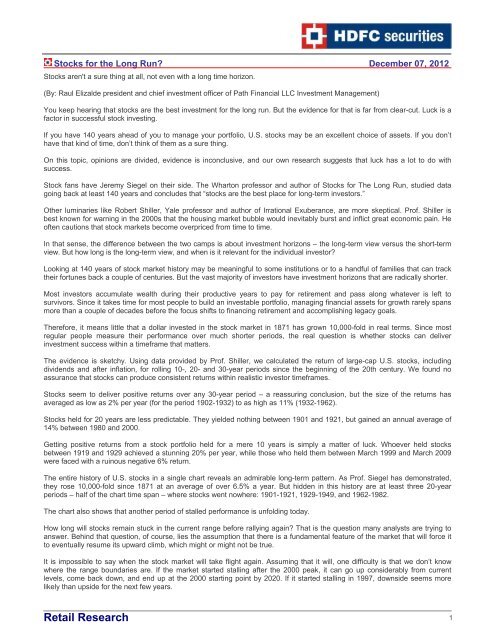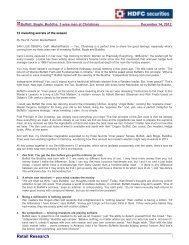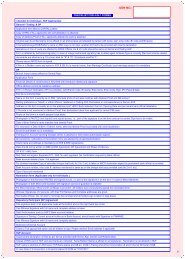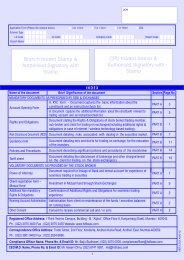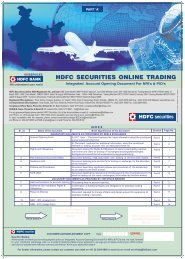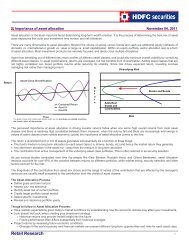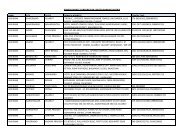Retail Research - HDFC Securities
Retail Research - HDFC Securities
Retail Research - HDFC Securities
Create successful ePaper yourself
Turn your PDF publications into a flip-book with our unique Google optimized e-Paper software.
Stocks for the Long Run? December 07, 2012Stocks aren't a sure thing at all, not even with a long time horizon.(By: Raul Elizalde president and chief investment officer of Path Financial LLC Investment Management)You keep hearing that stocks are the best investment for the long run. But the evidence for that is far from clear-cut. Luck is afactor in successful stock investing.If you have 140 years ahead of you to manage your portfolio, U.S. stocks may be an excellent choice of assets. If you don’thave that kind of time, don’t think of them as a sure thing.On this topic, opinions are divided, evidence is inconclusive, and our own research suggests that luck has a lot to do withsuccess.Stock fans have Jeremy Siegel on their side. The Wharton professor and author of Stocks for The Long Run, studied datagoing back at least 140 years and concludes that “stocks are the best place for long-term investors.”Other luminaries like Robert Shiller, Yale professor and author of Irrational Exuberance, are more skeptical. Prof. Shiller isbest known for warning in the 2000s that the housing market bubble would inevitably burst and inflict great economic pain. Heoften cautions that stock markets become overpriced from time to time.In that sense, the difference between the two camps is about investment horizons – the long-term view versus the short-termview. But how long is the long-term view, and when is it relevant for the individual investor?Looking at 140 years of stock market history may be meaningful to some institutions or to a handful of families that can tracktheir fortunes back a couple of centuries. But the vast majority of investors have investment horizons that are radically shorter.Most investors accumulate wealth during their productive years to pay for retirement and pass along whatever is left tosurvivors. Since it takes time for most people to build an investable portfolio, managing financial assets for growth rarely spansmore than a couple of decades before the focus shifts to financing retirement and accomplishing legacy goals.Therefore, it means little that a dollar invested in the stock market in 1871 has grown 10,000-fold in real terms. Since mostregular people measure their performance over much shorter periods, the real question is whether stocks can deliverinvestment success within a timeframe that matters.The evidence is sketchy. Using data provided by Prof. Shiller, we calculated the return of large-cap U.S. stocks, includingdividends and after inflation, for rolling 10-, 20- and 30-year periods since the beginning of the 20th century. We found noassurance that stocks can produce consistent returns within realistic investor timeframes.Stocks seem to deliver positive returns over any 30-year period – a reassuring conclusion, but the size of the returns hasaveraged as low as 2% per year (for the period 1902-1932) to as high as 11% (1932-1962).Stocks held for 20 years are less predictable. They yielded nothing between 1901 and 1921, but gained an annual average of14% between 1980 and 2000.Getting positive returns from a stock portfolio held for a mere 10 years is simply a matter of luck. Whoever held stocksbetween 1919 and 1929 achieved a stunning 20% per year, while those who held them between March 1999 and March 2009were faced with a ruinous negative 6% return.The entire history of U.S. stocks in a single chart reveals an admirable long-term pattern. As Prof. Siegel has demonstrated,they rose 10,000-fold since 1871 at an average of over 6.5% a year. But hidden in this history are at least three 20-yearperiods – half of the chart time span – where stocks went nowhere: 1901-1921, 1929-1949, and 1962-1982.The chart also shows that another period of stalled performance is unfolding today.How long will stocks remain stuck in the current range before rallying again? That is the question many analysts are trying toanswer. Behind that question, of course, lies the assumption that there is a fundamental feature of the market that will force itto eventually resume its upward climb, which might or might not be true.It is impossible to say when the stock market will take flight again. Assuming that it will, one difficulty is that we don’t knowwhere the range boundaries are. If the market started stalling after the 2000 peak, it can go up considerably from currentlevels, come back down, and end up at the 2000 starting point by 2020. If it started stalling in 1997, downside seems morelikely than upside for the next few years.<strong>Retail</strong> <strong>Research</strong> 1
None of this is truly helpful for making investment decisions over a year or two. But realizing that U.S. stocks are not aninvestment panacea is crucial for successful retirement planning. Counting only on U.S. stocks to grow a portfolio needed tofinance expenses during retirement can be dangerous.It doesn’t need to be that way. Today, investors have access to many risk assets beyond U.S. stocks. Prudent diversificationcan go a long way toward countering some of the disadvantages of placing all bets on U.S. stock returns that are uncertainover timeframes that matter to investors. Multi-faceted portfolios that include foreign and emerging market stocks, high-yielddebt, commodities, currencies and other assets should be central to investors’ quests for safer returns.Realizing this may be very difficult today. After three years of phenomenal U.S. stock performance, investors are tempted toconclude that Prof. Siegel is right by claiming that U.S. stocks are unbeatable. Mere chance will have to play a big role for thatto be true.(Source: www.morningstar.co.in)<strong>HDFC</strong> <strong>Securities</strong> Limited, I Think Techno Campus, Building ‘B’, “Alpha”, Office Floor 8, Near KanjurmargStation, Opposite Crompton Greaves, Kanjurmarg (East), Mumbai – 400042, Fax: (022) 30753435Disclaimer: This document has been prepared by <strong>HDFC</strong> <strong>Securities</strong> Limited and is meant for sole use by the recipient and not for circulation.This document is not to be reported or copied or made available to others. It should not be considered to be taken as an offer to sell or asolicitation to buy any security. The information contained herein is from sources believed reliable. We do not represent that it is accurate orcomplete and it should not be relied upon as such. We may have from time to time positions or options on, and buy and sell securities referredto herein. We may from time to time solicit from, or perform investment banking, or other services for, any company mentioned in thisdocument. . This report is intended for Non-institutional Clients only<strong>Retail</strong> <strong>Research</strong> 2


